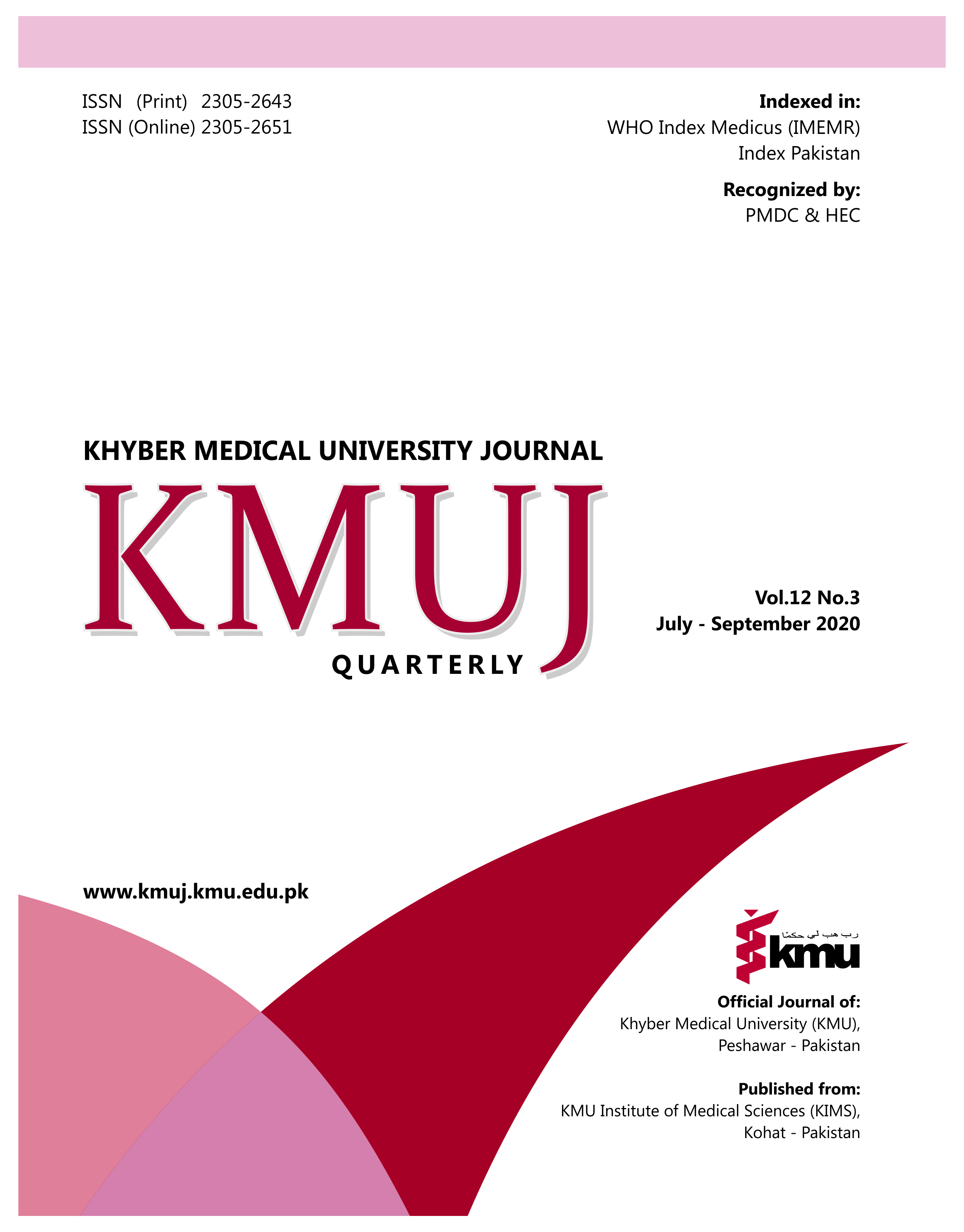COMPARISON OF SUCCESSFUL OUTCOME OF FLAP VERSUS NO-FLAP IN O’CONOR & SOKOL TECHNIQUE FOR VESICOVAGINAL FISTULA REPAIR
Main Article Content
Abstract
OBJECTIVE: To compare the successful outcome of flap versus no-flap in O’Conor & Sokol technique for simple vesicovaginal fistula (VVF) repair.
METHODS: This quasi-experimental study was conducted in department of Urology, Institute of Kidney Diseases, Hayatabad Medical Complex Peshawar, Pakistan from March 2015 to December 2019. During this study period, 64 eligible patients, selected through non-probability convenient sampling technique were assigned to two Groups. Group A included 34 patients who underwent VVF repair through O’Conor & Sokol technique without interposition flap while Group B comprised of 30 patients with VVF repair with interposition flap. Patient getting completely dry with no urinary incontinence at primary endpoint of 6 months was labelled as successful outcome. All the pre-operative, per-operative and post-operative data was collected on structured proforma and analyzed on SPSS version-21.
RESULTS: The mean age of the patient was 33.8±7.8 years in group A and 35±6.3 years in group B. About 76.5% (n=26/34) patients in group A and 80% (n=24/30) patients in Group B developed VVF due to obstetrical trauma. Overall, O’Conor and Sokol technique of VVF repair was successful by curing urinary incontinence in 95.3% (n=61/64) patients. Successful outcome for O’Conor & Sokol technique was achieved in 94.1% (n=32/94) patients in Group A and 96% (n=29/30) patients in Group B, at 6 months of follow-up (p>0.05).
CONCLUSION: There is no significant difference between interposition flap and no-flap in outcome of simple VVF repair through O’Conor & Sokol technique. The decision of interposition can be individualized depending upon preference of surgeon.
Article Details
Work published in KMUJ is licensed under a
Creative Commons Attribution 4.0 License
Authors are permitted and encouraged to post their work online (e.g., in institutional repositories or on their website) prior to and during the submission process, as it can lead to productive exchanges, as well as earlier and greater citation of published work.
(e.g., in institutional repositories or on their website) prior to and during the submission process, as it can lead to productive exchanges, as well as earlier and greater citation of published work.
References
Robert F. Zacharin. A History of Obstetric Vesicovaginal Fistula. Aust N Z J Surg 2000 Dec;70(12):851-4. DOI: 10.1046/j.1440-1622.2000.01990.x
Tunçalp Ö, Tripathi V, Landry E, Stanton CK, Ahmed S. Measuring the incidence and prevalence of obstetric fistula: approaches, needs and recommendations. Bull World Health Organ 2015;93(1):60-2. DOI: 10.2471/BLT.14.141473.
Malik MA, Sohail M, Malik MT, Khalid N, Akram A. Changing trends in the etiology and management of vesicovaginal fistula. Int J Urol 2018;25(1):25-9. DOI: 10.1111/iju.13419.
Dalela D, Ranjan P, Sankhwar PL, Sankhwar SN, Naja V, Goel A. Supratrigonal VVF repair by modified O'Connor's technique: an experience of 26 cases. Eur Urol 2006;49(3):551-6. DOI: 10.1016/j.eururo.2005.12.037.
Rehman SAU, Ahmad G, Hassan T, Ansari AS. Repair of vesicovaginal fistulae. Ann King Edward Med Univ 2011;17:80-5.
Altaweel WM, Rajih E, Alkhudair W. Interposition flaps in vesicovaginal fistula repairs can optimize cure rate. Urol Ann 2013;5(4):270–2. DOI: 10.4103/0974-7796.120305.
Wahab F, Nasir A, Manan F. Outcome of VVF repair without omental interposition. J Pak Med Assoc 2016;66(5):590-2.
Vangeenderhuysen C, Prual A, Ould el Joud D. Obstetric fistulae: incidence estimates for sub-Saharan Africa. Int J Gynaecol Obstet 2001;73(1):65-6. DOI:10.1016/s0020-7292(00)00374-x.
Sohail S, Siddiqui KJ. Trans-vaginal sonographic evaluation of vesicovaginal fistula. J Pak Med Assoc 2005;55(7): 292-4.
Rasool M, Mumtaz F, Tabassum SA. Vasicovaginal fistula repair. Urologist`s experience at Bhawalpur. Professional Med J 2006;13:445-52.
Javed A, Abdullah A, Faruqui N, Syed SS; Binat-ul-Mehdi, Pirzada AJ. Doctor! Will I be dry? Factors determining recurrence after vesicovaginal fistula repair. J Pak Med Assoc 2015;65(9):954-9.
Sih AM, Kopp DM, Tang JH, Rosenberg NE, Chipungu E, Harfouche M, et al. Association between parity and fistula location in Malawian women with obstetric fistula: a multivariate regression analysis. Br J Obstetr Gynecol 2016;123(5):831-6. DOI: 10.1111/1471-0528.13901.
Evans DH, Madjar S, Politano VA, Bejany DE, Lynne CM, Gousse AE. Interposition flaps in transabdominal vesicovaginal fistula repairs: are they really necessary? Urology 2001;57(4):670-4. DOI: 10.1016/S0090-4295(01)00933-5.
Singh V, Mehrotra S, Bansal A, Akhtar A, Sinha RJ. Prospective randomized comparison of repairing vesicovaginal fistula with or without the interposition flap: Result from a tertiary care Institute in Northern India. Turk J Urol 2019;45(5):377-83. DOI: 10.5152/tud.2019.85233
Reynolds WS, Gottlieb LJ, Lucioni A, Rapp DE, Song DH, Bales GT. Vesicovaginal fistula repair with rectus abdominus myofascial interposition flap. Urology 2008;71(6):1119-23. DOI: 10.1016/j.urology.2007.12.057.
